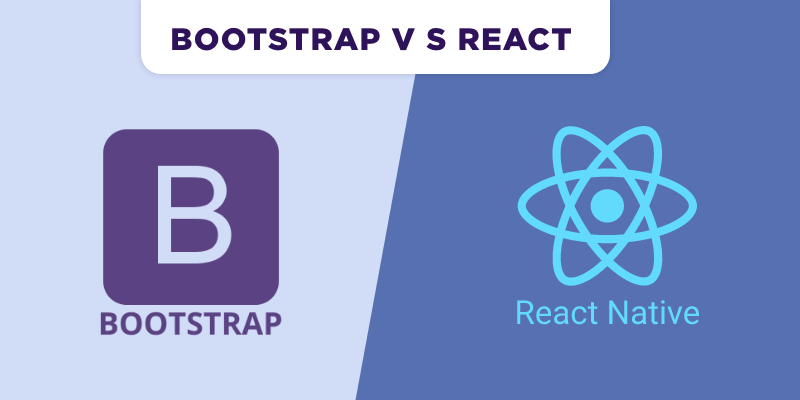It has been very easy to choose a frontend framework for a new project. Some people prefer the same one considering their comfort whereas others wish to try a new experience or learn a new skill that is profitable for their business in the long run. Bootstrap is often referred to as an open-source front-end toolkit, whereas Reactjs is a JavaScript library for building UI. Bootstrap has gained so much popularity in recent years and has become a great competition against React with an emerging market share of Bootstrap. Let’s read about Bootstrap Vs. React.
Both frameworks have their different features, characteristics, and qualities. Here the most important question that arises is, “Which among both the frameworks is the optimal framework for your project?”
To make you understand better, we have come up with a comprehensive guide on Bootstrap vs React and a comparison of 12 principal criteria that would let you choose the best and most suitable framework for your web application development.
Performance Comparison – Bootstrap Vs. React
It becomes quite essential to consider the performance factor while developing complex and bigger projects. Therefore, let’s have a closer look at the comparison between both frameworks in terms of performance.
How does Bootstrap stand out in terms of performance?
The user-centric ease for creating websites and developing applications makes Bootstrap unique. But, one has to watch it closely when it comes to performance. Sometimes developers don’t seem to like this framework due to its vast library and unutilized resources which leads to slower performance.
Keeping that aside, this framework also provides extensive customization features to increase the app’s performance, irrespective of it being content-heavy.
PhoneGap
The performance of React apps is faster and better in comparison to Bootstrap, a lightweight performance in user experience with individual components working in a fine functional manner. Reacts’ component-based architecture enables developing more robust single-page apps, reusability removes the code clutter and reduced DOM manipulation speeds up the page loading. These all characteristics make it a better framework that provides seamless app performance and a pleasing user experience.
Application Architecture – Bootstrap Vs. React
It is essential to go for flexibility while choosing a framework to avoid any strict enforcement of architecture and guidelines. In fact, a framework is more of a guide than methods and standards. Let’s compare Bootstrap vs. React to see how flexible these frameworks in terms of architecture are.
What kind of architecture does Bootstrap support?
Bootstrap’s architecture can be summarized as a View-View-Controller architecture due to the use of two components while building– Logic Layer and the View Layer. The views component is responsible for focusing explicitly on the visual displays, whereas the view-controller sets out all the visual components’ behavior within the framework. There are six modules within the view layer, while the logic layer has twelve components that provide unique functionality to a corresponding visual aid.
What kind of architecture does React support?
React does not have a built-in architecture pattern, unlike other libraries and frameworks. React caters to the view layer of the application that has components. Components in React work as functions that render the underlying user interface as the data changes. It’s a constant interaction between the users’ actions and the state of the application components that makes up the internal architecture of React.
Ease Of Testing – Bootstrap Vs. React
Your app development project requires going through a series of tests to make sure compliance with the UI standards, compatibility, and usability to avoid glitches under any circumstances like high load or growing market expectations. Let’s see how these two frameworks stand out in terms of testing.
How easy is it to test a Bootstrap app?
For testing Bootstrap apps or websites, external plugins and compatible tools can be used as there are no internal components within Bootstrap for running tests. The perks of using this framework are that it eliminates cross-browser bugs due to its single coding component which is reusable and no repetition is required.
How easy is it to test a React app?
Reactjs provides key test runners, and the development process becomes easier with the help of these tools. The test runners examples like Jest, Mocha, and more let’s practice a standard pattern of executing test suites that help testers identify problems in real browser environments, unnecessary functions, and the spot where expensive manipulation of functions execute. It decreases the time-to-market, speeds up the deployment of apps, and gives a push to a more productive environment.
Scalability – Bootstrap Vs. React
Frameworks influence the scalability of the web application significantly. So, it is important to choose the right framework. Let’s see how these frameworks stand out in terms of scalability.
Is Bootstrap scalable?
Bootstrap is a mobile-first development framework, so, one can rely on this framework for developing scalable websites and applications. With Bootstrap, responsive website content can be scaled up or down based on the browser, application, or screen used by the user. The framework also eliminates cross-browser bugs and compatibility problems with its single universal codes and makes it preferable amongst developers.
Is React scalably?
As React apps are built of pure javascript, developers can rely on traditional ways to organize the code to make the project more scalable. React is an outstanding framework to build scalable UIs pertaining to the concept of virtual DOM and component reusability.
Suitability For Building Complex Applications
Official documents, third-party libraries, guidelines, plugins, and open-source projects are offered by both Bootstrap and React for the support of developers during the development process. Let’s compare Bootstrap vs. React in terms of developing complex applications.
Is Bootstrap suitable for building complex apps?
Being amongst the popular HTML/CSS/JS frontend frameworks, Bootstrap easily passes off for developing complex applications. The framework offers a variety of in-built components, themes, templates, themes, and other resources that are useful during the development process depending on the requirements of the project.
Is React suitable for building complex apps?
React js supports the development of extremely interactive single-page applications. Also, it provides support from external server-side rendering architecture such as Flux, Redux, and SSR frameworks like Next.js. Hence, you can develop complex applications with the help of code management capabilities offered by react js.
Security – Bootstrap Vs. React
The implementation and management of security controls within an organization are guided by technology and framework. Hence, it becomes very important to offer best practices for building a secure app. Let’s now compare Bootstrap vs. React in terms of security offered by them.
How does Bootstrap handle security?
Security vulnerabilities are very common in frontend frameworks, and Bootstrap also falls on the list that is prone to threats. Specifically, Bootstrap is prone to XSS vulnerabilities through the data-target attribute, and this issue is also reported earlier by the developers even with the updated versions.
How is security handled in React?
The applications that are React-based are more prone to threats like XSS vulnerabilities, SQL injections, Server-side rendering attacks, and a few more. Now it completely is in the hands of developers to implement the best practice that will protect your app from such sort of security threats.
User Experience – Bootstrap Vs. React
Another very important element for selecting the correct framework for your project is the user experience it will offer. Let’s compare Bootstrap vs. React in terms of the user experience offered by them.
Bootstrap’s ability to give the best user experience
Twitter Bootstrap aims at being a web-responsive frontend framework to provide a standardized and best user experience. The responsive design of the framework offers the web users, viewers, and developers consistency across all platforms which will help you to increase the trust and boost the value of your application. The easily available templates, drop-down menus, themes, sliders, etc. help your app to offer an amazing user experience.
React’s ability to give the best user experience
React applications offer a high-quality user interface and fast rendering of web pages that make them more likely to be adopted by users. The applications incorporate rich user interfaces with a clean, everything-on-place system. The UI components like buttons, text boxes, and others are very well built such that it makes it very comfortable during the interaction. React apps offer smooth third-party integrations and user experience.
Rapid Development – Bootstrap Vs. React
There are projects where we need to consider Low Time to Market which is why we need to select a framework that offers the process of rapid development. Let’s compare Bootstrap and React in terms of rapid developments.
How does Bootstrap contribute to rapid application development?
The frontend framework is popular for quickly developing applications and saves time with the help of its extensive documentation. Bootstrap is development-friendly and also its libraries consist of several class components that make it a framework that does not require any sort of coding knowledge for the development of the applications.
The Bootstrap implementation just requires the basic knowledge about a markup language HTML and styling basics like CSS preprocessors. The readily available components like JS plugins and documented synergy save the time and energy needed to remember each elements’ specifications. The cross-browser compatibility and consistency of Bootstrap reduces the bugs on different platforms and helps in upgrading an app in a very short period.
How does React contribute to rapid application development?
React demands an in-depth understanding of choosing the router system, configuration caveats, and problem-solving attitude at various stages of the project lifecycle. If you have a resource team that is skillful and has already experience on several projects then you will find React more quick and efficient. If you aim for short-term goals then you will definitely get amazing results by using React.
Application Size – Bootstrap Vs. React
The framework you choose affects the application. If the project is large, then the size of the app should dominate the framework’s size. Let’s differentiate between Bootstrap vs. React in terms of application size.
What is Bootstrap application size?
The supplication sizes of bootstrap vary according to the content of design and presentation. A comprehensive and simple Bootstrap application would have a minimum file size of 49 KB in JavaScript and a CSS file size of 137 KB.
Regardless of the minimum application size, developers would have to be wary of the library packages’ unused components that can bulk up an app.
What is React’s application size?
React is just a library and not a completely featured frontend framework like Angular. Looking from this point of view, it should make an application that is smaller than those frameworks, but the app sizes of React are even bigger comparatively. The latest version of React has minimized the overall bundle size which reduces the size of the application by 30 percent as compared to the previous one.
Code Maintainability – Bootstrap Vs. React
The framework that you select should be easy to maintain and adapt. For any application development, the term maintainability refers to the ease provided to the developers in analyzing the code and moving ahead to fix any sort of errors, thus offering the correct functionality. Let’s compare Bootstrap and React in terms of code maintainability.
How convenient is it to maintain code in Bootstrap apps?
Bootstrap is a UI framework that helps in developing responsive web applications. The ready-made class components, templates, and utility packages are already available for use without even the need of writing the code for development. The flexibility of class components makes the applications workable for multiple sites and platforms. The availability of reusable code omits the rewriting process for separate devices. Therefore, the consistency and cross-browser compatibility of the components reduces bugs while developing the application, making it beginner’s friendly for team projects.
How convenient is it to maintain code in React apps?
React’s architecture is component-based. It focuses on building UI components, custom functionalities in a user interface, and optimally using logic to build meaningful functionalities. Once you start developing your application with React, you are developing functional and individual code snippets. These code snippets are reusable to other applications, as well as different modules of the application. Dividing applications into some parts helps you manage the app more efficiently. Hence, this ultimately improves the efficiency of developers.
Learning Curve
The organizations understand the time frame required for the project development with the aid of a learning curve. It helps the developers to become proficient in the given framework. Let’s differentiate between Bootstrap and React in terms of a learning curve.
How good is the learning curve of Bootstrap for developers?
A developer-friendly framework is provided by Bootstrap. A small learning curve exists for the developers who have more experience with CSS and HTML basics. The task becomes easy by learning about the CSS classes and Bootstrap components. Also, it uses a completely different approach as compared to other frameworks, i.e., developing mobile-centric applications, and developers may have to adapt to the new style.
How good is the learning curve of React for developers?
The developers having experience with Javascript can easily learn React. It takes very little time for experienced developers to learn about the workflow and architecture of React because of the thorough understanding of API structures and data flow in Javascript. Its short learning makes the establishment of a team easier as any developer who is a beginner or experienced can join the team. Even if we talk about a crucial time when the developer might leave your team, you still don’t have to worry as the resources are easily available in the market.
Conclusion
Both frameworks Bootstrap and React are high in demand and close competitors when it comes to designing and customizing the best UI for web applications. React is a component-based framework whereas Bootstrap is a template-based frontend framework that provides ready-made templates for building applications. You can choose the best framework as per your project requirements considering the unique features and facilities provided by both these frameworks.
FAQs
What is Bootstrap?
Bootstrap is an open-source front-end CSS framework for building mobile-first websites. While the front-end framework template is on CSS, it also supports HTML templates and JavaScript components like jQuery. This UI development framework is second in popularity due to its multi-site interoperability and responsive design templates.
What is React.Js?
React.Js is a free JavaScript toolkit for creating interactive web applications. React allows developers to build reusable bespoke components that speed up development. Its ability to generate web pages quickly also makes it more search engine friendly. Overall, it is an excellent library for building sophisticated and straightforward commercial apps.
What are the benefits of Bootstrap?
Creates a user interface that is responsive in style and structure and is cross-platform compatible. Excellent documentation on each component and easily accessible tools assist debug sites fast. LESS, a CSS preprocessor may speed up bespoke development.



